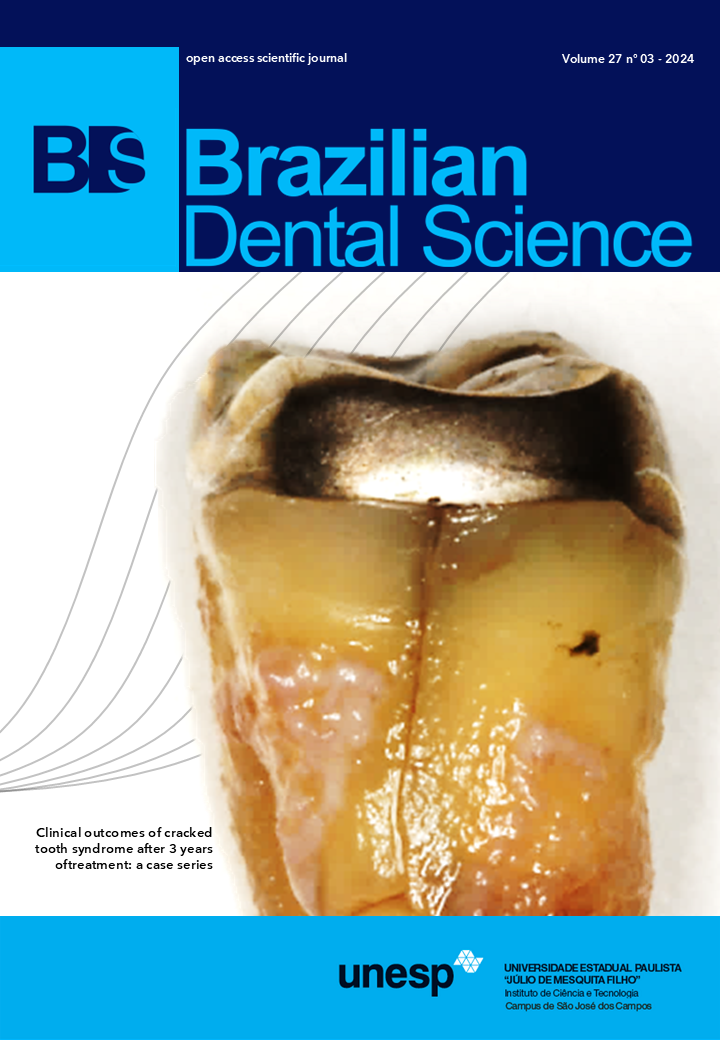Antifungal effect of Quillaja saponaria plant extract on biofilms of five Candida species of dental interest
DOI:
https://doi.org/10.4322/bds.2024.e4233Resumo
Objective: The objective of this study was to evaluate the action of Q. saponaria glycolic extract on the biofilms of standard strains of C. albicans, C. glabrata, C. krusei, C. dubliniensis, and C. tropicalis. Material and Methods: Monomicrobial biofilms of the five Candida species were grown for 48 h, followed by treatment with the isolated extract at five concentrations (100 mg/mL, 50 mg/mL, 25 mg/mL, 12.5 mg/mL, and 6.25 mg/mL) and two times of exposure to treatment in all groups (5 min and 24 h), the untreated group, and the group treated with 0.12% chlorhexidine (CLX). To analyze cell viability, the MTT test was used, and the optical densities were transformed into a percentage of metabolic activity. In statistical analysis, data were analyzed by ANOVA and Tukey’s test, considering a significance level of 5%. Results: The biofilms, when analyzed after a time of 5 minutes, showed fungal reduction when exposed to treatments at 5 concentrations of Quilaia extracts when compared to the untreated group. This applies to the species of C. albicans, C. glabrata, C. krusei, and C. dubliniensis (p<0.0001), as only the biofilms formed by C. tropicalis, despite providing reduction, did not show significant differences between the groups. At 5 minutes, only the biofilms of C. albicans, C. grabrata, and C. krusei treated with Quilaia extract 100 mg/mL showed superior and significant results compared to the group treated with CLX, but at a concentration of 50 mg/mL, only group C. albicans. Within 24 h, all groups and all concentrations of Quilaia demonstrated antifungal action (p<0.0001). Despite showing a reduction greater than or similar to that promoted by CLX in 24 hours when comparing concentrations of 100 mg/mL and 50 mg/mL, the C. albicans groups showed statistically significant differences in this comparison and at this time (p<0.0001). Conclusion: Therefore, Quilaia extract demonstrated high antifungal potential and was capable of acting on the reduction of Candida spp. biofilms at both treatment exposure times and concentrations.
KEYWORDS
Candida; Quilaia; Phytotherapy; Biofilm; Plant extracts.
Downloads
Downloads
Publicado
Como Citar
Edição
Seção
Licença
TRANSFERÊNCIA DE DIREITOS AUTORAIS E DECLARAÇÃO DE RESPONSABILIDADE
Toda a propriedade de direitos autorais do artigo "____________________________________________________________________" é transferido do autor(es) para a CIÊNCIA ODONTOLÓGICA BRASILEIRA, no caso do trabalho ser publicado. O artigo não foi publicado em outro lugar e não foi submetido simultaneamente para publicação em outra revista.
Vimos por meio deste, atestar que trabalho é original e não apresenta dados manipulados, fraude ou plágio. Fizemos contribuição científica significativa para o estudo e estamos cientes dos dados apresentados e de acordo com a versão final do artigo. Assumimos total responsabilidade pelos aspectos éticos do estudo.
Este texto deve ser impresso e assinado por todos os autores. A versão digitalizada deverá ser apresentada como arquivo suplementar durante o processo de submissão.




























